Introduction
- The world is about to enter a massive change in demographics.
- Improvements in the quality of life.
- Increases in the average lifespan.
- 20% of the US population will be 65 years or older by 2050.
- Increased pressure on the healthcare sector.
The elderly have always been one of the primary recipients of healthcare services around the world. Old age is associated with higher vulnerability to diseases, increased chances of trauma, and other related healthcare issues. Naturally, they make up for the majority of hospital treatments and long-term hospitalizations. However, this situation is soon to change. Number of older adults worldwide would double from 900 million to 1.6 billion by 2030, and grow further to reach the 2 billion mark by 2050 (WHO, n.d.). This represents a major challenge for healthcare systems worldwide. The USA will face the issue of demographic changes as well, as 20% of the US population will be 65 year or older by 2050 (WHO, n.d.). The purpose of this presentation is to analyze the impact of demographic changes on healthcare in the US through the lens of organizational development.

US Population Growth Rate
- Birth rate in the US is 1.84 children per woman.
- The percentage increase in population for the past 3 years is roughly 0.71%.
- Marginal growth is achieved due to net immigration and reduced mortality rates.
- Potential increase in patient-per-nurse ratio.
According to statistical research, the US population has been growing steadily for the past 50 years or so. The USA has one of the largest populations in the world, scoring at third place, after China and India. This presents a set of unique challenges to the healthcare system, as the ever-increasing number of people would require more doctors and nurses to take care of them. According to Buerhaus, Skinner, Auerbach and Staiger (2017), the increase in the overall population rates, coupled with the existing shortage of nurses, will cause issues due to higher patient-per-nurse ratios and decreased quality of care.
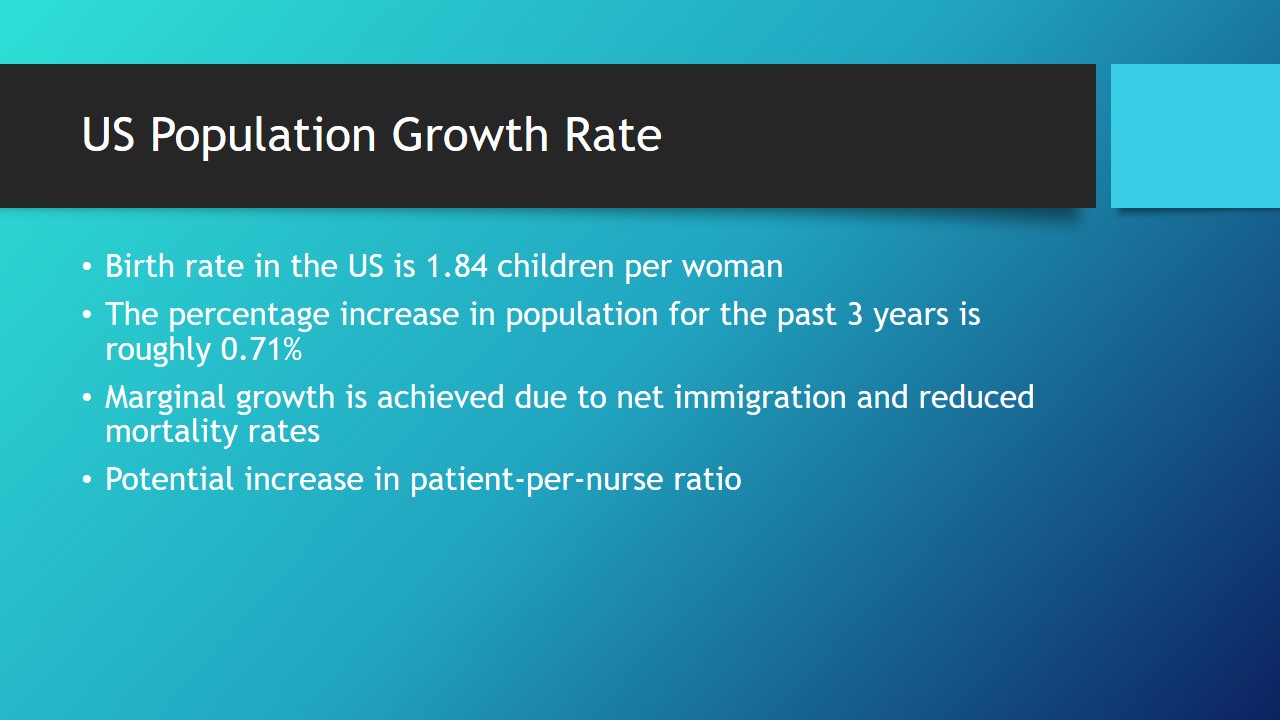
US Population Aging Rate
- US population is aging rapidly.
- The number of US citizens aged 65 and above will double.
- Current number: 48 million.
- Projected number: 96 million.
- Baby boomers eligible for retirement since 2011 (Ricketts, 2011).
The aging demographic in the US has been alarming ever since the 2000s. The immediate healthcare deficit is largely associated with Baby Boomers, one of the largest generation groups in the country, entering retirement and relying on the existing healthcare system to maintain their health. This means an increased influx of patients with multiple comorbidities and high susceptibility for hospitalization. Treating these patients requires additional staff and resources. The projected numbers for the US population in the next 40 years include members of other generations entering retirement. With no changes to the existing healthcare system organization, the country would need twice as many nurses and doctors as it has now.

Racial and Ethnical Diversity
- US population keeps growing due to net immigration.
- The number of migrants in the US is estimated to grow from 44 to 78 million in the next 40 years.
- Approximately 1 million migrants per year.
- The majority of migrants to the US come from Mexico, Latin America, and Asia.
- Religion composition in the US is slowly changing, the number of non-Christians is growing (Valentine, Wynn, & McLean, 2016).
Due to its economic prosperity, political freedoms, and working opportunities, the USA has been a choice country for migration less fortunate countries, such as Mexico, Cuba, China, India, El Salvador, Guatemala, and others. Legal migrants typically naturalize and become US citizens, thus creating an additional challenge for the healthcare system, which needs to accommodate these individuals based on their ethnic, cultural, religious, and individual needs. It is very possible for nurses of the future to be required to be bilingual or possibly tri-lingual to be able to efficiently treat migrants and individuals of various racial and ethnical backgrounds (Valentine et al., 2016).

Healthcare Challenge: Workforce Supply
- Existing workforce shortage is at 13,800 primary care physicians.
- Forecasted shortages at 20,000 physicians by 2025.
- Estimated shortages for 2030 – between 40000 and 120,000 physicians.
- Workforce supply shortages associated with greater number of patients requiring long-term care.
According to Dall et al. (2013), the prevalence of manageable chronic diseases in the US’s aging population would require a greater number of primary care and specialized physicians. This statement is supported by the data provided by the Senate Health, Education, Labor, and Pension (HELP) commission in cooperation with the Health Resources and Services administration (HRSA). Long-term care requires personnel to treat, clean, educate, and take care of stationary residents as well as operate all kinds of medical equipment meant for routine scans and checkups. In addition, the expectations towards healthcare by the Baby Boomer generation will be higher, resulting in greater requirements for the quality of care (Kahana & Kahana, 2014).

Healthcare Challenge: Demand for Chronic and Long-Term Services
- Longer life expectancy is associated with the ability to manage chronic diseases.
- New diseases associated with sedentary life, pollution, and exposure will require treatment.
- Chronic and long-term services become more affordable.
- Increased quality of treatment.
Dall et al. (2013) state that the quality of life, along with quality of care, have increased exponentially over the course of the last century. In 1900, the average life expectancy of a US citizen was 47 years, whereas in 2018 it is at 73 years. This number is expected to grow up to 80 years in 2050. Chronic care would be required to handle various heart, lung, and kidney diseases, as well as obesity-related illnesses. Mobility issues would become a pressing matter, as many elders experience falls and suffer from a lack of accommodations for limited mobility individuals. Falls are some of the main causes of trauma and morbidity in elderly patients (Satariano et al. 2012).
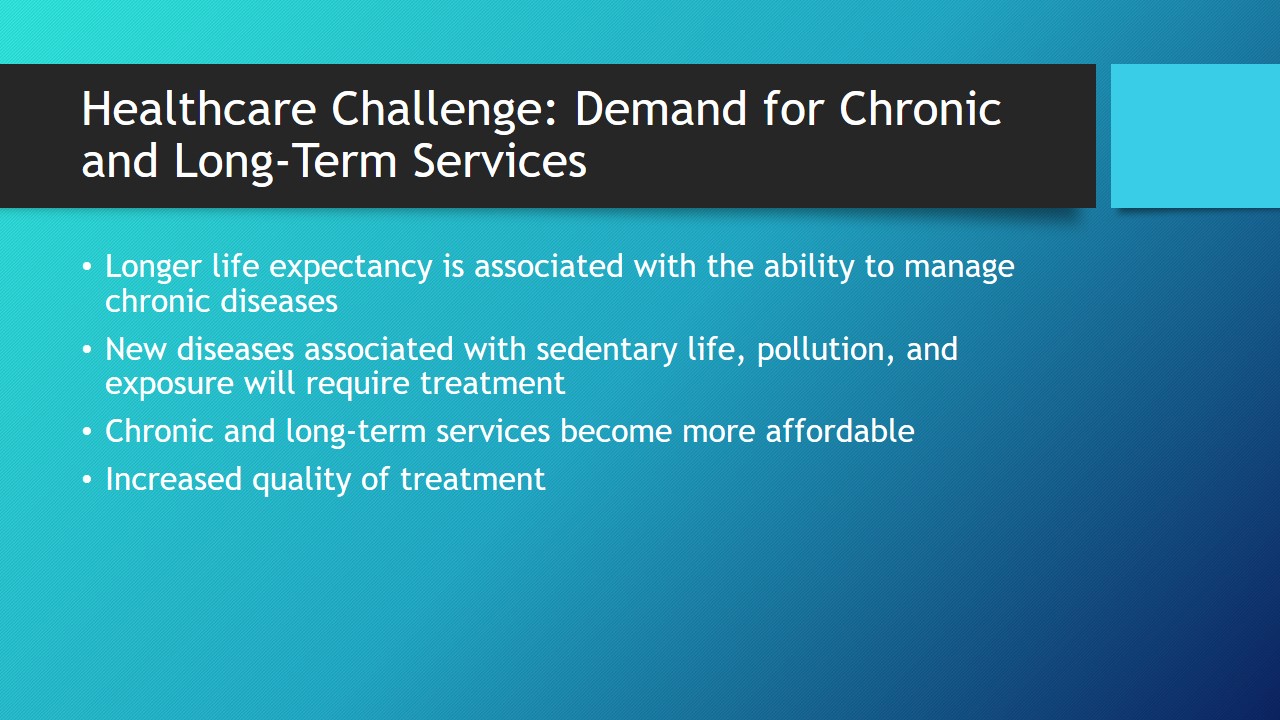
Healthcare Challenge: Demand for Diversity
- There will be 78 million immigrants in the USA by 2050.
- Immigration will expose the healthcare system to numerous different religions and cultures.
- Healthcare workers will be expected to handle the diversity with respect and care.
- The majority of nurses in service today are likely to be underprepared.
The demands for diversity training in modern healthcare are already reasonably high. Nurses are expected to be able to converse on a simple level in both English, Hispanic, and several other languages in use on the territory of the US. In addition, there is plenty of educational material on different aspects of cultures and religions that are present in this country. According to Phillips and Malone (2014), increasing diversity in nursing and promoting diversity training leads to lower disparities of health and better outcomes, which would be necessary to curb the increased workloads associated with rehospitalization and poor primary treatment. At the same time, diversity training is likely to increase the time needed for preparation of a nurse, thus potentially contributing to workforce supply shortages.
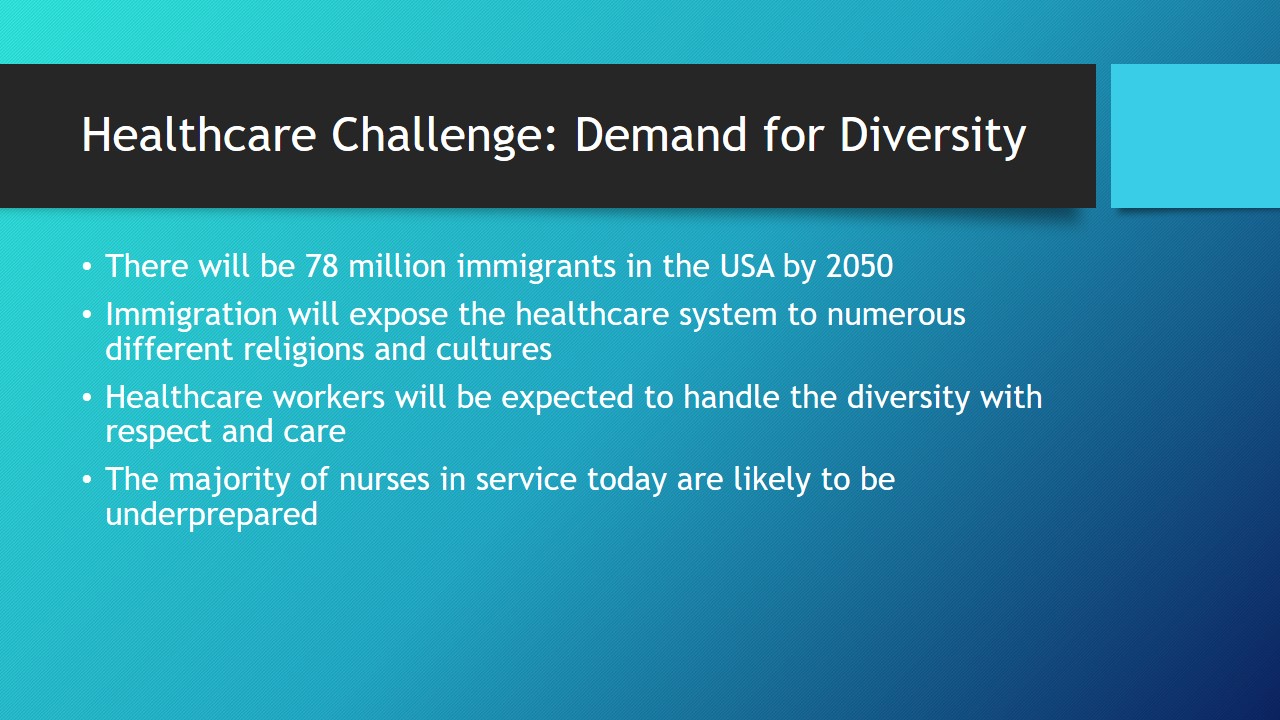
Organizational Aspects and Potential Solutions
- The existing healthcare system has to be transformed on an organizational level in order to ensure high quality and volume of performance.
- Competition for skilled workers will be high.
- Standards and approaches to professional education will need to be changed.
- Communication between nurses and patients on all levels.
- Promotion of work/life balance.
In order to answer the challenges created by the demographic challenges and already shaping the landscape of national healthcare, hospitals, government, social and educational institutions will have to undergo a massive organizational overhaul. The primary goals would be to reduce the workforce supply deficit by making the profession more attractive to various individuals, training and recruiting more nurses, and also by making the healthcare system more efficient. Reducing nurse turnover, making use of communication technology, and promoting preventive care would help ensure the overall health and stability of a rapidly aging population (Grady, 2011).
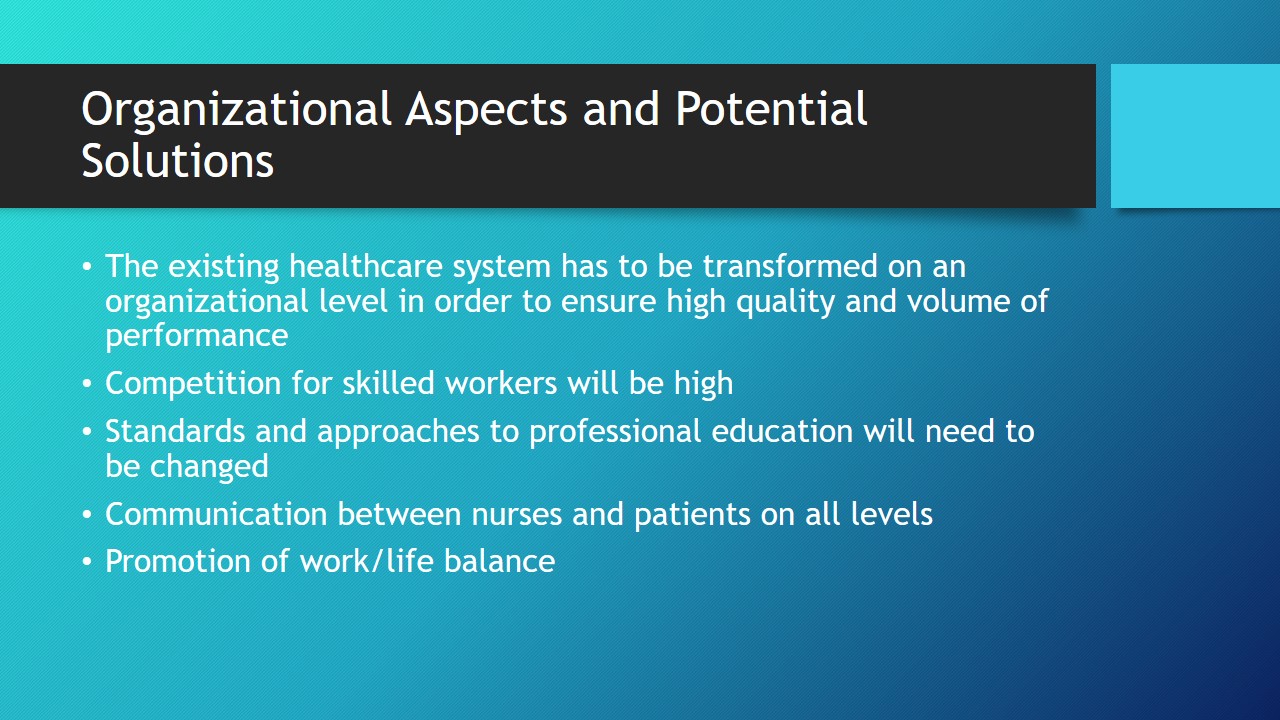
Organizational Transformation of Healthcare
- Use of flexible scheduling in accordance with patient flow.
- Heavy use of communication technology to reduce workload on nurses.
- Greater expectations for quality of care.
- Expanding the workforce to include more full-time nurses.
- Implementing modularity in healthcare.
All predictions suggest that the US healthcare industry will be facing the demographics crisis while understaffed. As such, it is of paramount importance to improve the efficiency of existing system in order to account for more patients with chronic diseases needing long-term care. Competent scheduling and thrifty spending is key to maintaining a relative status quo. Flexible scheduling will be used to maintain a steady patient-per-nurse ratio during high and low workload periods. Hospitals and primary care facilities as a whole would need to be expanded to include more full-time nurses working in long-term care. Soffers, Meijboom, and Hsuan (2016) suggest the implementation of modularity to improve healthcare outcomes.

Reorganization of Medical Education
- Medical education must be made more available.
- Expanded internships might help reduce hospital workloads.
- Emphasis on diversity training.
- A better balance of theory and practice.
While hospital reorganization might help increase the production output of healthcare facilities, it will not solve the primary problem in US healthcare – there are not enough nurses. With old nurses retiring and high turnover rates washing out many young nurses in their first three years of service, the system needs to reorganize medical education. It must be made available to everyone, including poor families and individuals from various ethnical backgrounds (Telio, Ajjavi, & Regehr, 2015). In addition, the current curriculum focuses too much on theory and too little on practice, which leads to slow and inefficient work. Making nurses familiarized with hospitals from their very first year of learning would help remedy that.

Reduction of High Turnover Rates
- US hospital turnover rate is at 19%.
- Reducing turnover rates would help preserve employees.
- Turnover reduction = cost reduction.
- Better work/life balance.
- 8-hour shifts (in the long run).
One of the major reasons why most US hospitals are understaffed is because of high turnover rates. Healthcare jobs are stressful, the hours are poor, and there is a high chance of burnout along the way. Many nurses drop out after 1-2 years in the profession. In order to make sure that US healthcare system withstands the influx of numerous geriatric patients in the next 20 years, it is paramount to make healthcare a comfortable profession. It is possible to improve work satisfaction by introducing servant leadership as a basis for nurse-supervisor interaction, and include various appreciation programs to make nurses feel rewarded for their efforts (Trastek, Hamilton, & Niles, 2014).
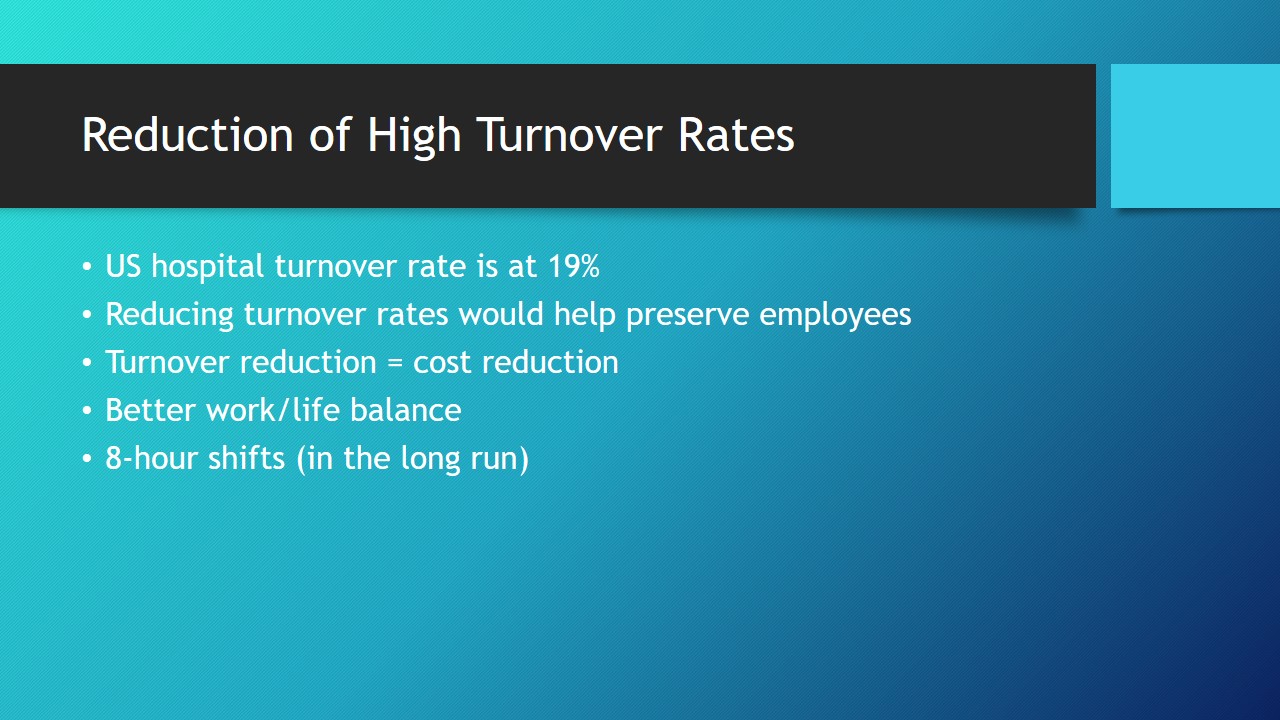
Conclusions
- Geriatric population in the USA will double by 2050.
- The number of immigrants will increase.
- US hospital system is not prepared for the workload increase.
- Quality healthcare depends on hospital organization and education reforms.
A potential demographic crisis is looming over the US healthcare industry. As it stands, we are woefully unprepared for the drastic increases in patient numbers. As it stands, the healthcare system is underfunded and understaffed. However, there are numerous opportunities for improvement. By making healthcare one of the nation’s top priorities and making significant reforms to the existing organizational and educational structures, it would be possible to provide the aging population with enough nurses, doctors, and other specialists. Changes to the program to include more diversity training would help reduce the discrepancies between population groups and provide a uniform standard of care.
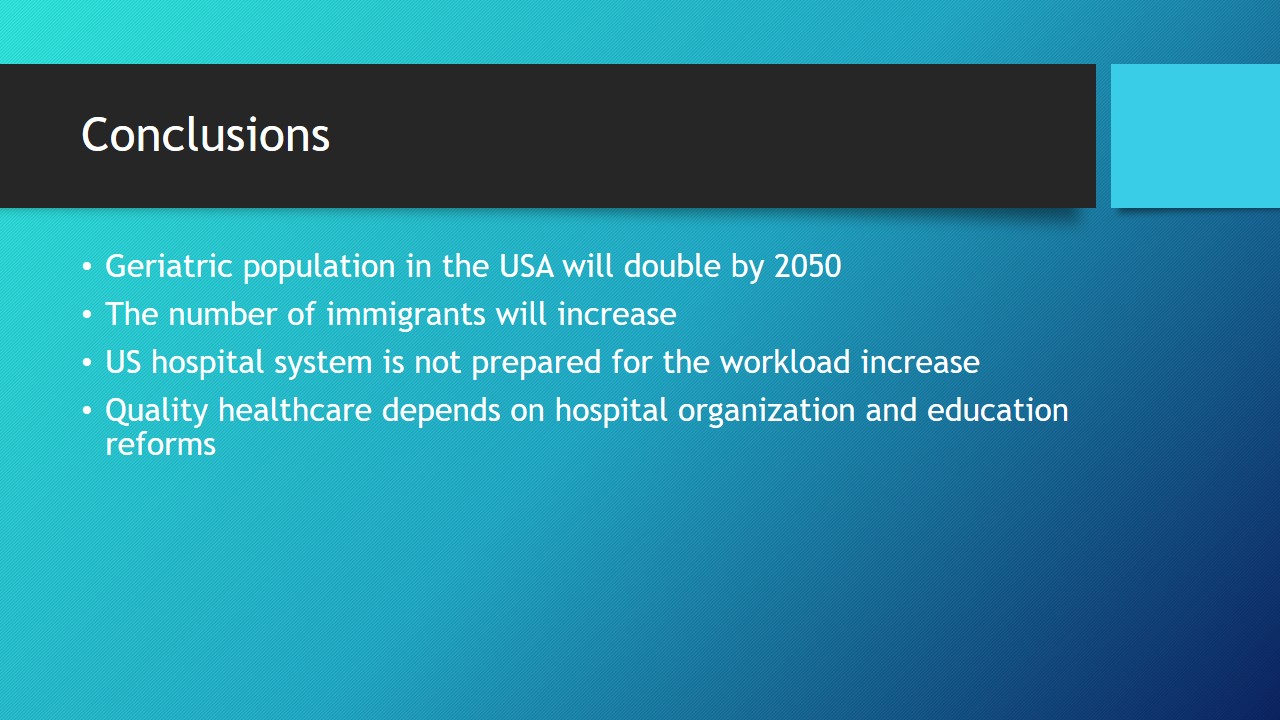
References
Buerhaus, P. I., Skinner, L. E., Auerbach, D. I., & Staiger, D. O. (2017). Four challenges facing the nursing workforce in the United States. Journal of Nursing Regulation, 8(2), 40-46.
Dall, T. M., Gallo, P. D., Chakrabarti, R., West, T., Semilla, A. P., & Storm, M. V. (2013). An aging population and growing disease burden will require a large and specialized healthcare workforce by 2025. Health Affairs (Project Hope), 32(11), 2013-2020.
Grady, P. A. (2011). Advancing the health of our aging population: A lead role for nursing science. Nursing Outlook, 59(4), 207-209.
Kahana, E., & Kahana, B. (2014). Baby boomers’ expectations of health and medicine. Virtual Mentor, 16(5), 380-384.
Phillips, J. M., & Malone, B. (2014). Increasing racial/ethnic diversity in nursing to reduce health disparities and achieve health equity. Public Health Reports, 129, 45-50.
Ricketts, T. C. (2011). The health care workforce: will it be ready as the boomers age? A review of how we can know (or not know) the answer. Annual Review of Public Health, 32, 417-430.
Satariano, W. A., Guralnik, J. M., Jackson, R. J., Marottoli, R. A., Phelan, E. A., & Prohaska, T. R. (2012). Mobility and aging: New directions for public health action. American Journal of Public Health, 102(8), 1508-1515.
Soffers, R., Meijboom, B., & Hsuan, J. (2016). Principles for implementing modularity in healthcare. 23rd EurOMA Conference, 1-14.
Telio, S., Ajjavi, R., & Regehr, J. (2015). The “Educational Alliance” as a framework for reconceptualizing feedback in medical education. Academic Medicine, 90(5), 609-614.
Trastek, V. F., Hamilton, N. W., & Niles, E. E. (2014). Leadership models in healthcare – A case for servant leadership. Mayo Clinic Proceedings, 89(3), 374-381.
Valentine, P., Wynn, J., & McLean, D. (2016). Improving diversity in the health professions. North Carolina Medical Journal, 77(2), 137-140.
WHO. (n.d.). “Global health and aging.”. Web.